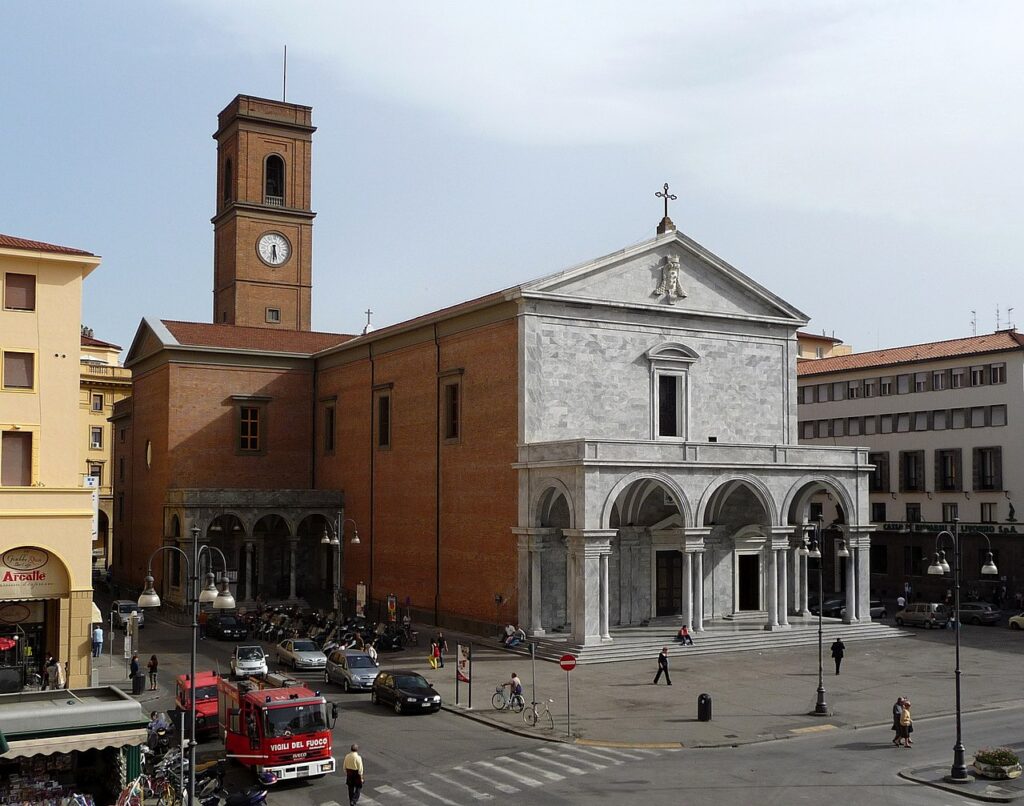Iniziata nel 1594 Su disegno di AlessandroPieroni la cattedrale fu consacrata nel 1606. Nel 1607 fu eretto il campanile e nel ‘700 furono aggiunte le cappelle laterali e il transetto. Distrutta dai bombardamenti della seconda guerra mondiale fu ricostruita secondo il modello originale. Il duomo ha pianta a croce latina con navata unica. La facciata, molto semplice, è preceduta da un portico marmoreo con colonne binate doriche sormontato da terrazze. Le opere d’arte conservate all’interno sono per lo più quelle originali, in gran parte restaurate. Del soffitto in legno intagliato da Vincenzo Ricordati detto l’Imperatore non resta purtroppo traccia e al suo posto si possono ammirare tre grandi tele: “Trionfo di Santa Giulia” di Jacopo Ligozzi, “Assunzione della Madonna” di Domenico Cresti da Passignano, “San Francesco che riceve il bambino da Maria” di Jacopo Chimenti da Empoli, dipinte tra 1619 e 1623.
Begun in 1594 Based on a design by AlessandroPieroni, the cathedral was consecrated in 1606. In 1607 the bell tower was erected and in the 1700s the side chapels and the transept were added. Destroyed by the bombings of the Second World War, it was rebuilt according to the original model. The cathedral has a Latin cross plan with a single nave. The very simple façade is preceded by a marble portico with Doric coupled columns surmounted by terraces. The works of art preserved inside are mostly the original ones, largely restored. Unfortunately, no trace remains of the carved wooden ceiling by Vincenzo Remembered, known as the Emperor, and in its place you can admire three large canvases: “Triumph of Santa Giulia” by Jacopo Ligozzi, “Assumption of the Madonna” by Domenico Cresti da Passignano, “San Francis receiving the child from Mary ”by Jacopo Chimenti da Empoli, painted between 1619 and 1623.
Entrando, sulla destra, monumento al marchese Marco Alessandro Del Borro (1702 – 1705), opera di Giovan Battista Foggini, a cui segue quello dedicato al conte Carlo Ginori, entrambi celebri governatori di Livorno. L’altare maggiore riccamente decorato con marmi pregiati, presenta ai lati due testine d’angelo erroneamente attribuite al fiammingo François Duquesnoy ed è sovrastato da un crocifisso settecentesco con croce moderna.
Entering, on the right, a monument to the Marquis Marco Alessandro Del Borro (1702 – 1705), the work of Giovan Battista Foggini, followed by the one dedicated to Count Carlo Ginori, both famous governors of Livorno. The high altar, richly decorated with precious marbles, has two angel heads on the sides erroneously attributed to the Flemish François Duquesnoy and is surmounted by an eighteenth-century crucifix with a modern cross.





